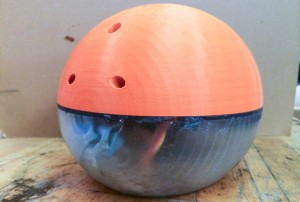The 3D printers at MIT, and there are many of them, are kept busy week in and week out. One of the latest projects involving 3D printing from the Massacheusetts Institute of Technology comes from Sampriti Bhattacharyya — a graduate student in mechanical engineering — in the form of a submersible robot.
Sampriti reportedly designed the oval, football-sized robot, together with her advisor Ford Professor of Engineering Harry Asada, initially as a solution for identifying cracks in the water tanks of nuclear reactors. However, further applications for the water loving android have also surfaced, with the proposition that it could also be used to inspect boats and ships in port to search for false hulls and propeller shafts that conceal contraband and are often used by smugglers, according to MIT News.

For the proposed in-port inspection application Sampriti says: “It’s very expensive for port security to use traditional robots for every small boat coming into the port. If this is cheap enough — if I can get this out for $600, say — why not just have 20 of them doing collaborative inspection? And if it breaks, it’s not a big deal. It’s very easy to make.”
3D printing was used to produce the main structural components of the robot, and the part of the external structure that demanded permeable properties. This is the part that contains the original propulsion system consisting of six pumps that expel water through rubber tubes. The set up of these six pumps and tubes are key to how the robot operates — two of the tubes vent on the opposite side to the flattened panel, to ensure proximity to the surface being inspected, while the other four tubes vent in pairs at opposite ends of the robot’s long axis to control locomotion.
The other part of the robot is necessarily watertight to house its control circuitry, battery, a communications antenna and an inertial measurement unit, it will ultimately house the ultrasound sensor too. Development is still in the early stages, with testing confirming the principles of operation. However, Sampriti is already working on the next iteration which will likely include improvements that include wirelessly rechargeable batteries as well as modifications to the propulsion system. The MIT researchers are also exploring mechanical systems that would create hydrodynamic buffers of just the right depth to enable the robot to perform ultrasound scans without surface contact.
Nathan Betcher, a special-tactics officer in the U.S. Air Force, is also interested in how this research develops. He told MIT News: “I have a great deal of interest in seeing if this type of technology can have a substantive impact on a number of missions or roles which I might be charged with in the future. I am particularly interested to see if this type of technology could find use in domestic maritime operations ranging from the detection of smuggled nuclear, biological, or chemical agents to drug interdiction, discovery of stress fractures in submerged structures and hulls, or even faster processing and routing of maritime traffic.”



